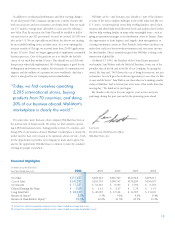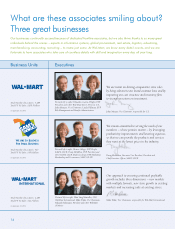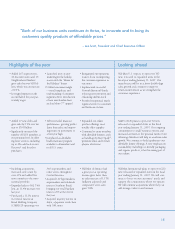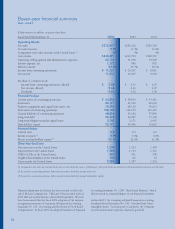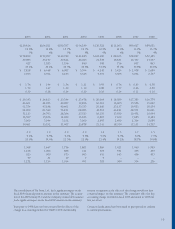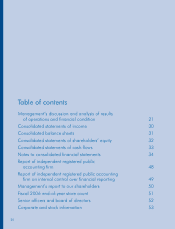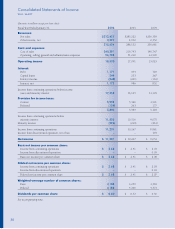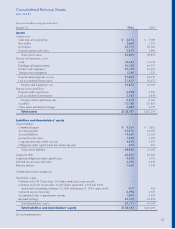Walmart 2006 Annual Report Download - page 23
Download and view the complete annual report
Please find page 23 of the 2006 Walmart annual report below. You can navigate through the pages in the report by either clicking on the pages listed below, or by using the keyword search tool below to find specific information within the annual report.
Overview
Wal-Mart Stores, Inc. (“Wal-Mart” or the “Company”) is a global
retailer committed to improving the standard of living for our cus-
tomers throughout the world. We earn the trust of our customers
every day by providing a broad assortment of quality merchandise
and services at every day low prices (“EDLP”) while fostering a
culture that rewards and embraces mutual respect, integrity and
diversity. EDLP is our pricing philosophy under which we price
items at a low price every day so that our customers trust that our
prices will not change erratically under frequent promotional activ-
ity. Our focus for SAM’S CLUB is to provide exceptional value on
brand-name merchandise at “members only” prices for both busi-
ness and personal use. Internationally, we operate with similar
philosophies. Our fi scal year ends on January 31.
We intend for this discussion to provide the reader with informa-
tion that will assist in understanding our fi nancial statements, the
changes in certain key items in those fi nancial statements from year
to year, and the primary factors that accounted for those changes, as
well as how certain accounting principles affect our fi nancial state-
ments. The discussion also provides information about the fi nancial
results of the various segments of our business to provide a bet-
ter understanding of how those segments and their results affect
the fi nancial condition and results of operations of the Company
as a whole. This discussion should be read in conjunction with
our fi nancial statements and accompanying notes as of January 31,
2006, and the year then ended.
Throughout this Management’s Discussion and Analysis of Results
of Operations and Financial Condition, we discuss segment oper-
ating income and comparative store sales. Segment operating
income refers to income from continuing operations before net
interest expense, income taxes and minority interest. Segment
operating income does not include unallocated corporate over-
head. Comparative store sales is a measure which indicates the
performance of our existing stores by measuring the growth in
sales for such stores for a particular period over the corresponding
period in the prior year. For fi scal 2006 and prior years, we consid-
ered comparative store sales to be sales at stores that were open as
of February 1st of the prior fi scal year and had not been expanded
or relocated since that date. Stores that were expanded or relocated
during that period are not included in the calculation. Comparative
store sales is also referred to as “same-store” sales by others within
the retail industry. The method of calculating comparative store
sales varies across the retail industry. As a result, our calcula-
tion of comparative store sales is not necessarily comparable to
similarly titled measures reported by other companies. Beginning
in fi scal 2007, we changed our method of calculating comparative
store sales. These changes are described in our Current Report on
Form 8-K that we furnished to the SEC on February 2, 2006.
On May 23, 2003, we consummated the sale of McLane Company,
Inc. (“McLane”), one of our wholly-owned subsidiaries, for $1.5
billion. As a result of this sale, we classifi ed McLane as a discontin-
ued operation in the fi nancial statements for fi scal 2004. McLane’s
external sales prior to the divestiture were $4.3 billion in fi scal
2004. McLane continues to be a supplier to the Company.
Operations
Our operations are comprised of three business segments: Wal-Mart
Stores, SAM’S CLUB and International.
Our Wal-Mart Stores segment is the largest segment of our busi-
ness, accounting for approximately 67.2% of our fi scal 2006 net
sales. This segment consists of three traditional retail formats, all
of which are located in the United States, and Wal-Mart’s online
retail format, Walmart.com. Our traditional Wal-Mart Stores retail
formats include:
• Supercenters, which average approximately 187,000 square feet
in size and offer a wide assortment of general merchandise and a
full-line supermarket;
• Discount stores, which average approximately 102,000 square
feet in size and offer a wide assortment of general merchandise
and a limited assortment of food products; and
• Neighborhood Markets, which average approximately 42,000
square feet in size and offer a full-line supermarket and a limited
assortment of general merchandise.
Our SAM’S CLUB segment consists of membership warehouse
clubs in the United States and the segment’s online retail format,
samsclub.com. SAM’S CLUB accounted for approximately 12.7%
of our fi scal 2006 sales. Our SAM’S CLUBs in the United States
average approximately 129,000 square feet in size.
As of January 31, 2006, our International operations were
located in nine countries and Puerto Rico. Internationally, we
generated approximately 20.1% of our fi scal 2006 sales. Outside
the United States, we operate several different formats of retail
stores and restaurants, including supercenters, discount stores
and SAM’S CLUBs. Additionally, at January 31, 2006, we owned
an unconsolidated 33.3% minority interest in Central American
Retail Holding Company (“CARHCO”), a retailer operating in
fi ve Central American countries. In February 2006, we acquired
a controlling interest in CARHCO.
The Retail Industry
We operate in the highly competitive retail industry in both the
United States and abroad. We face strong sales competition from
other discount, department, drug, variety and specialty stores and
supermarkets, many of which are national chains. Additionally, we
compete with a number of companies for prime retail site locations,
as well as in attracting and retaining quality employees (“associ-
ates”). We, along with other retail companies, are infl uenced by a
number of factors including, but not limited to: cost of goods, con-
sumer debt levels, economic conditions, interest rates, customer
preferences, employment, labor costs, infl ation, currency exchange
fl uctuations, fuel prices, weather patterns and insurance costs. Our
SAM’S CLUB segment faces strong sales competition from other
wholesale club operators, as well as other retailers. Further infor-
mation on risks to our Company can be located in Item 1A, Risk
Factors, in our Annual Report on Form 10-K for the year ended
January 31, 2006.
Management’s Discussion and Analysis of Results of Operations
and Financial Condition
WAL-MART
21




